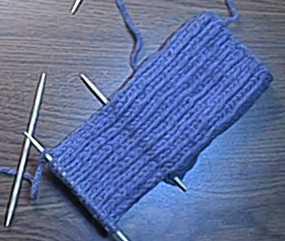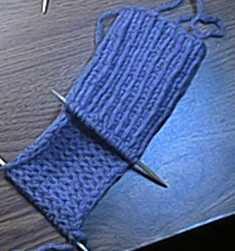Wednesday, October 12, 2005
Day of Wrath
This post had another, kinder, gentler name. But &%$#@ Blogger ate it! And three copies of the draft.
So, shall we try again?
Yes, let's.

Okay, you'll putting aside one of your needles after the next row. Put it somewhere that you'll be able to find it later, NOT where someone will sit on it! Sitting on a short dpn is unpleasant at best. And you might break the needle, too!
Heel flap: You'll be working with the first 18 stitches (needle 1 and 1/2 of needle 2).
Row 1 (RS): With your "spare needle, insert the tip into the first stitch on the left needle as if you were going to purl the stitch, slip it onto the spare (right) needle without knitting it (that's a "slip 1" or "sl 1, "as if to purl"), knit the next stitch. Repeat these two stitches 9 times total (18 stitches worked) all onto the same needle you started with. You now have 18 stitches on one needle, 6 on the second, and 12 on the third. Slip the 6 stitches of needle 2 onto needle 3. You now have 2 empty needles, 18 worked stitches on one needle, and 18 unworked stitches on the other. (Look at the picture!) Set the extra needle aside. You need only 3 for the time being.
The unworked 18 stitches will be "held" on their needle until the heel is finished.
Turn your sock around so that you can knit back over the stitches you just formed.
Row 2 (did you think I forgot?): WS: slip 1, purl across, turn. Notice that on the wrong side (inside of your sock) you are slipping only the first stitch of the row. Repeat these 2 rows until you have worked 24 rows total.
If you lose track of your rows, count the elongated stitches (the ones you slipped), There will be 12 of them when you are done.

And here's what your heel flap looks like on the outside. Sort of like ribbing, but "cushy" and soft (to pad the heel of your sock).

Here's what it looks like on the inside. Those slipped stitches form an extra layer (sort of like the inside of stranded colorwork). They make the heel sturdier so that it won't wear out as fast.
Here's a tip: knitting socks at a tight gauge (going down a couple of needle sizes relative to the size recommended for the yarn weight) will also help them to wear better. That's why I am using 5's with yarn that calls for US 7s.
Tomorrow: The dreaded "heel turn." Faith and patience, Grasshopper!
.
So, shall we try again?
Yes, let's.

Okay, you'll putting aside one of your needles after the next row. Put it somewhere that you'll be able to find it later, NOT where someone will sit on it! Sitting on a short dpn is unpleasant at best. And you might break the needle, too!
Heel flap: You'll be working with the first 18 stitches (needle 1 and 1/2 of needle 2).
Row 1 (RS): With your "spare needle, insert the tip into the first stitch on the left needle as if you were going to purl the stitch, slip it onto the spare (right) needle without knitting it (that's a "slip 1" or "sl 1, "as if to purl"), knit the next stitch. Repeat these two stitches 9 times total (18 stitches worked) all onto the same needle you started with. You now have 18 stitches on one needle, 6 on the second, and 12 on the third. Slip the 6 stitches of needle 2 onto needle 3. You now have 2 empty needles, 18 worked stitches on one needle, and 18 unworked stitches on the other. (Look at the picture!) Set the extra needle aside. You need only 3 for the time being.
The unworked 18 stitches will be "held" on their needle until the heel is finished.
Turn your sock around so that you can knit back over the stitches you just formed.
Row 2 (did you think I forgot?): WS: slip 1, purl across, turn. Notice that on the wrong side (inside of your sock) you are slipping only the first stitch of the row. Repeat these 2 rows until you have worked 24 rows total.
If you lose track of your rows, count the elongated stitches (the ones you slipped), There will be 12 of them when you are done.

And here's what your heel flap looks like on the outside. Sort of like ribbing, but "cushy" and soft (to pad the heel of your sock).

Here's what it looks like on the inside. Those slipped stitches form an extra layer (sort of like the inside of stranded colorwork). They make the heel sturdier so that it won't wear out as fast.
Here's a tip: knitting socks at a tight gauge (going down a couple of needle sizes relative to the size recommended for the yarn weight) will also help them to wear better. That's why I am using 5's with yarn that calls for US 7s.
Tomorrow: The dreaded "heel turn." Faith and patience, Grasshopper!
.
Labels: knit recipes
Comments:
<< Home
Ann, a question about needles size - do you knit loose and usually go down 1 or 2 needle sizes? I do, so I was just wondering if I should stick with 5's or go down more since I am a loose knitter.
I am usually at (or very close) to "ball band" gauge. Conventional wisdom dictates that socks be knitted "firmly" so I generally go down "a couple" of needles sizes. In this case, the ball band on my chosen yarn calls for 7s. I used 5s.
The idea is to make a firm (but not bulletproof) fabric.
The idea is to make a firm (but not bulletproof) fabric.
Ann,
Help! I got to this part and as I begun the part where I should have 4 unworked stitches, I have FIVE!
I can photograph the sock as it is now for you to look at.
Is it okay for me to send stuff to your personal mailbox?
Also, do you have a copy of the sock pattern? If I need to take the sock to my LYS, they might need the pattern to help me with it.
My email is: theresan@rnovak.net
Post a Comment
Help! I got to this part and as I begun the part where I should have 4 unworked stitches, I have FIVE!
I can photograph the sock as it is now for you to look at.
Is it okay for me to send stuff to your personal mailbox?
Also, do you have a copy of the sock pattern? If I need to take the sock to my LYS, they might need the pattern to help me with it.
My email is: theresan@rnovak.net
<< Home




![[HeettheFeet20083.jpg]](https://blogger.googleusercontent.com/img/b/R29vZ2xl/AVvXsEiCRH_T42wVcDuEXnRRcJTi8Xx0pZMjwaEvKKUYxkKGb3RbfVJvbBKJaplnruL4Y1lQGy9LWjb2KhOsPi10kdPRppP6_O47YprEco3m4iD3JMmT1o-7Hc6zuCWJT-0gxesUCp_H/s1600/HeettheFeet20083.jpg)
![[mittnz2008buttin.jpg]](https://blogger.googleusercontent.com/img/b/R29vZ2xl/AVvXsEjhkbBquqYIEHAWQxsnQtaptULuJ-jj-mlpdjbffH9r1n1liR1r8yRRkXMgJLBxbeo0x3w2wU_gLhjFzrxzKrMmVgUGSqAzkP89jlWOA04Xhr2pWmVGIDgt8VGWAK-FZMfwB6j6/s1600/mittnz2008buttin.jpg)
![[heet2009-1.jpg]](https://blogger.googleusercontent.com/img/b/R29vZ2xl/AVvXsEi4SiW5ds26X6RV2guuohZ5nCdtljV9Pj8cVQCebCBg8EYaQR_DXHlIgLihx-5ddowYTS8hM11_JCwqlbN0qLGhUHjIsea9xw5v9tu4Cdnn0dHCRU5NXLAN-VH_o7jT1WW3w74R_w/s320/heet2009-1.jpg)
![[mittnz 2009 button.jpg]](https://blogger.googleusercontent.com/img/b/R29vZ2xl/AVvXsEjpuGtaAayAUpfk3b8FnVyyIvB5jI1YxPMmcN2M9PyQo9MfDK9JVxgFz2z7rLFuGjebz7CBV-frRyUYMXFzFLmwtP_xmCwd9HEgKylZaZwzwfSV8xTZ5a6vayaG0oEbFxgjYFTa5w/s320/mittnz+2009+button.jpg)